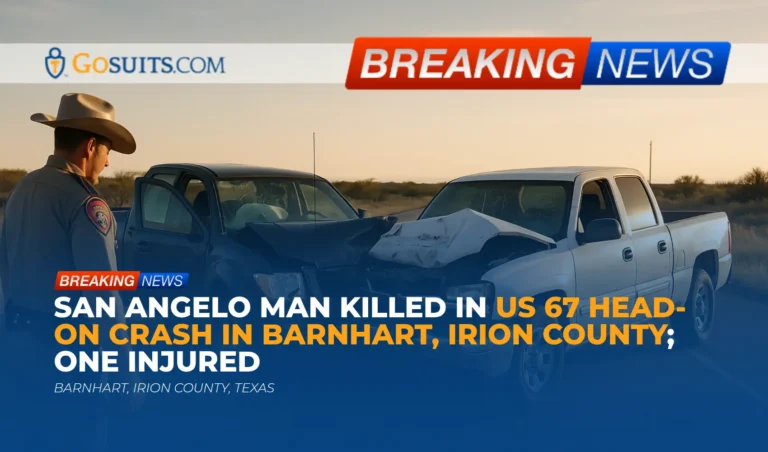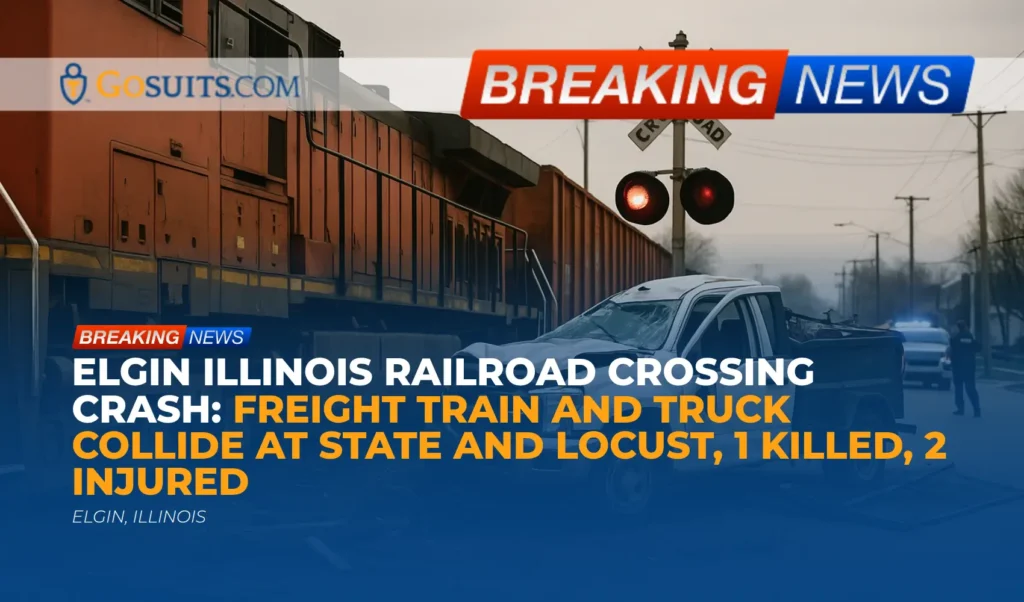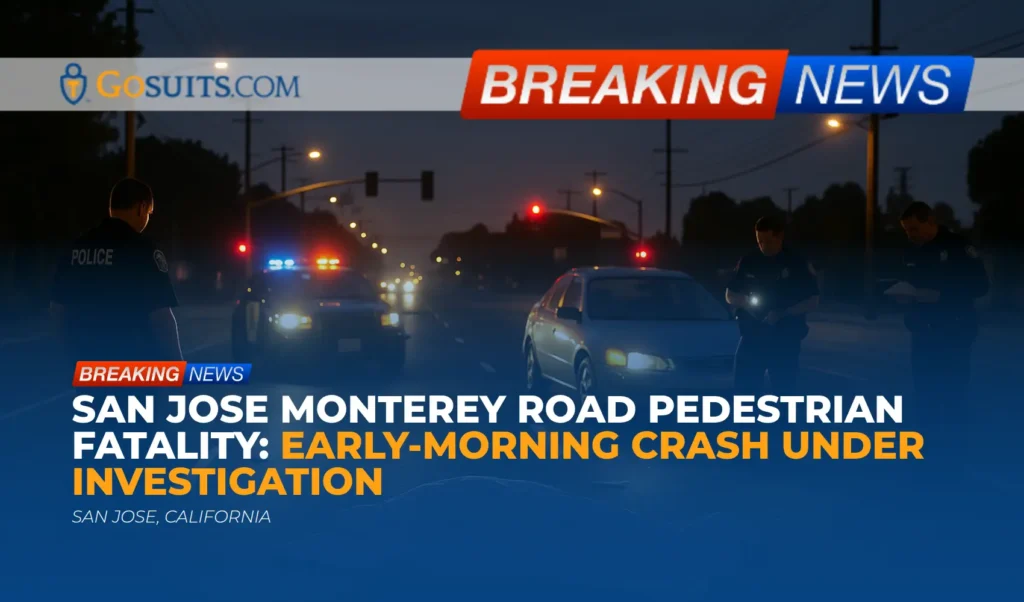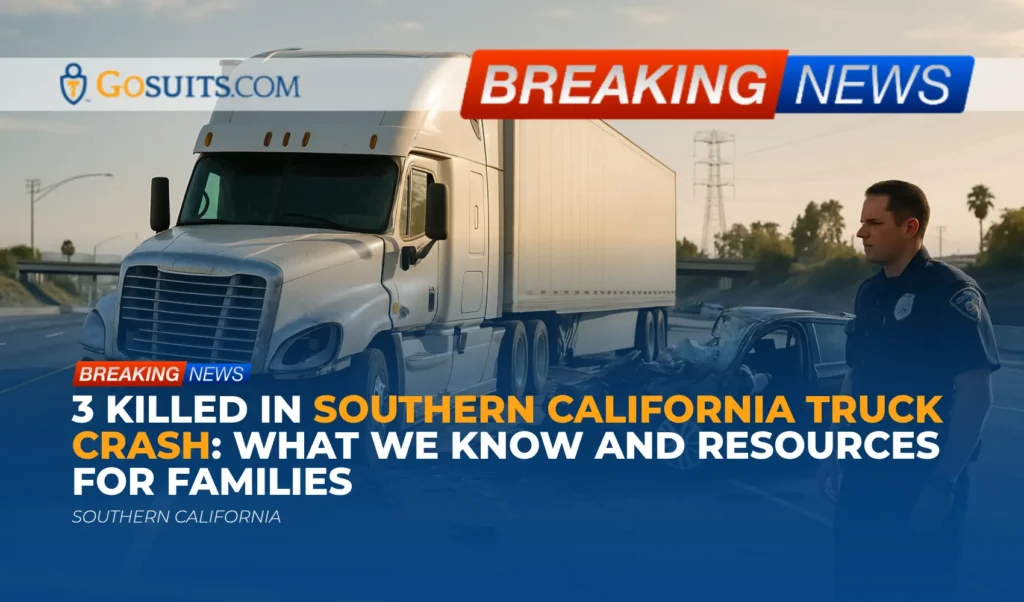- What we know about the Irion County head-on collision
- When and where it happened, and immediate conditions
- How to request official records and documents
- How head-on collisions are investigated in Texas
- Texas civil law rights after a fatal crash
- Potential civil liability and insurance considerations
- Time limits and preserving crucial evidence
- Practical steps to document losses and navigate insurance
- Support and community resources
- Commentary from Gosuits Barnhart, Texas Personal Injury Attorney
- Why timely action matters
What we know about the Irion County head-on collision
A head-on collision in Irion County resulted in the death of a 52-year-old driver from San Angelo. The crash occurred on U.S. Highway 67 at North First Street in Barnhart, Texas. According to information released by the Texas Department of Public Safety, a 2008 Mitsubishi Raider traveling westbound on U.S. 67 crossed into the eastbound lane and struck a 2003 Chevrolet Silverado traveling eastbound. The driver of the Silverado, a 52-year-old San Angelo resident identified publicly in local reporting as David Brent, was pronounced deceased at the scene by Justice of the Peace Donna Smith. The driver of the Mitsubishi Raider, a 52-year-old male from Boerne, was transported to Shannon Medical Center with serious injuries. Weather at the time was reported as clear and dry. The preliminary account indicates a lane-departure head-on impact.
When a head-on collision occurs, the energy exchange is typically severe, and survivability often depends on speed, seat belt use, vehicle size, and impact angle. Rural highways like U.S. 67 can present additional risks due to higher speeds and longer response times. Federal highway safety officials recognize rural roadway departures as a major source of serious and fatal injuries, and they support countermeasures like centerline rumble strips and improved lane markings where feasible. For general background on rural roadway risks, see the National Highway Traffic Safety Administration’s information on rural transportation safety at NHTSA.
When and where it happened, and immediate conditions
Time and date: Friday, October 17, at approximately 4:34 p.m. This timing places the crash in late afternoon traffic, when sun position and end-of-week travel may affect driver workload.
Location: U.S. Highway 67 at North First Street, Barnhart, Irion County, Texas. Barnhart is an unincorporated community along U.S. 67, a corridor that carries local and through traffic, including light commercial vehicles.
Weather and roadway: Clear and dry conditions. Even in clear weather, lane departures can occur for many reasons, including distraction, fatigue, medical events, vehicle mechanical issues, or evasive maneuvers. The preliminary information does not state a cause. A formal crash report and further investigation often provide more detail.
How to request official records and documents
Families and involved parties often need official documents to understand what happened, settle estates, and address insurance claims. In Texas, several agencies can help.
1. Peace Officer’s Crash Report, photographs, and supplements
In Texas, law enforcement crash reports are centrally managed through the Texas Department of Transportation’s Crash Records Information System. Eligible requestors can purchase the Peace Officer’s Crash Report, known as a CR‑3, along with any available attachments. Request online through TxDOT’s Crash Records portal at TxDOT CRIS Purchase.
The report typically includes a diagram, narrative, vehicle and driver information, and contributing factors coded by the investigating officer. It is a foundational document for insurance claims and civil investigations.
2. Death investigation, inquest findings, and death certificate
In counties without a medical examiner system, a Justice of the Peace generally conducts inquests into certain unattended or unexpected deaths. The Texas Code of Criminal Procedure governs inquests, autopsies, and related procedures. See Chapter 49 at the Texas Legislature’s official site: Code of Criminal Procedure, Chapter 49.
Families can request information about the inquest from the appropriate Justice of the Peace office in Irion County. Availability of records can vary, and certain sensitive information may be limited by law.
For certified death certificates, the Texas Department of State Health Services, Vital Statistics Section, provides instructions for ordering. Visit Texas DSHS Vital Statistics. Certified copies are often required for estate and insurance matters.
3. Medical records for the injured
Medical records for an injured person are generally confidential. A patient or authorized representative may request copies. Federal privacy rules under HIPAA explain how individuals can access their records. See the U.S. Department of Health and Human Services guidance at HHS Medical Records Rights.
4. Vehicle information, towing, and data downloads
Vehicles involved in serious crashes may be towed to secure lots. It is important to identify the tow location quickly. Modern vehicles often contain an Event Data Recorder that stores pre-crash and crash data such as speed and braking. NHTSA provides an overview of EDR systems at NHTSA Event Data Recorder. Accessing this data can require specialized tools and coordination with owners, insurers, or custodians.
How head-on collisions are investigated in Texas
Texas peace officers document crash scenes using recognized methods that include scene measurement, vehicle inspection, and witness statements. The goal is to determine how and why the crash occurred. Typical steps include:
- Scene documentation: Photographs, roadway measurements, skid or yaw marks, debris fields, and final rest positions. These details help reconstruct vehicle paths and impact points.
- Vehicle inspections: Checking for pre-impact mechanical issues, airbag deployments, occupant restraint use indicators, and crash damage patterns that confirm a head-on configuration.
- Interviews: Statements from surviving drivers, passengers, and witnesses. Officers may also canvass nearby businesses for cameras that might show approach paths or traffic conditions.
- Records checks: License and insurance verification, as well as checks for recalls or mechanical defects if indicated.
- Environmental factors: Sun angle near sunset, roadway alignment, and signage. Clear, dry conditions reduce weather complicators, but sightlines and glare may still be relevant depending on the direction of travel.
- Data and diagnostics: Downloading EDR data when available and permitted, and if crash severity triggers a record.
Because the preliminary information here indicates a westbound vehicle crossed into the eastbound lane and struck an oncoming vehicle, investigators will focus on why that lane departure occurred. Texas law requires drivers to keep to the right of the roadway except when passing or when the roadway is divided otherwise. See Texas Transportation Code Section 545.051. Potential factors can include distraction, fatigue, impairment, sudden medical issues, avoiding obstacles, or mechanical failure. At this stage, no specific cause has been reported.
Families often have questions about timing. Peace Officer’s Crash Reports are typically available within several days to a few weeks, depending on complexity and whether specialized analysis is needed. Supplemental reports may follow.
Texas civil law rights after a fatal crash
In Texas, certain family members may bring a civil action arising from a wrongful death, and the decedent’s estate may bring a survival claim for damages the person could have recovered if they had lived. These rights exist to provide a civil remedy separate from any criminal process. The main statutes are:
- Wrongful death: Texas Civil Practice and Remedies Code Chapter 71 allows the spouse, children, and parents to bring a claim for the losses they suffer as a result of a loved one’s death. See Chapter 71.
- Survival action: Section 71.021 allows the decedent’s estate to pursue claims the decedent would have had, including conscious pain and suffering prior to death and certain medical and funeral expenses. See Section 71.021.
Each case is fact specific. Generally, if an at-fault driver breaches a duty of ordinary care and causes a fatal injury, civil liability may arise. Head-on collisions often involve allegations of negligence related to lane use, speed, distraction, or other unsafe driving behaviors. It is important to note that the preliminary report does not attribute fault beyond describing the lane departure. A full evaluation typically requires the official crash report and supporting evidence.

Who may bring claims
Under Chapter 71, the surviving spouse, children, and parents may bring wrongful death claims. If eligible family members do not file within the required period, the executor or administrator of the estate may bring the claim for the benefit of those family members. The survival claim is brought by the estate’s representative. See Texas Civil Practice and Remedies Code, Chapter 71.
Potential civil liability and insurance considerations
In a two-vehicle head-on crash where one vehicle crosses into the oncoming lane, civil fault is often in dispute until the evidence is collected and analyzed. A civil claim might involve several layers:
- At-fault driver’s liability insurance: Texas requires drivers to carry minimum liability coverage, which is intended to pay for injury and death caused to others up to policy limits.
- Uninsured and underinsured motorist coverage: If the at-fault driver lacks adequate coverage, UM or UIM on the victim’s policy can help, subject to terms and limits. These coverages are optional but widely purchased.
- Personal Injury Protection or MedPay: PIP is optional in Texas, though insurers must offer it. It can cover certain medical and related costs regardless of fault.
- Third-party responsibility: In limited cases, other parties may be implicated, for example, a negligent entrustment theory if a vehicle owner knowingly allowed an unsafe driver to operate the vehicle, or roadway maintenance issues if evidence supports such a claim. These theories are highly fact dependent.
Insurance claims can be complex. The Texas Department of Insurance provides general consumer guidance about auto insurance and claim handling at TDI Auto Insurance Consumer Help. Insurers will often seek recorded statements and authorizations early. It is prudent to speak with a qualified attorney first, because statements given to insurers can be used to limit or deny claims later.
Key questions that often arise in head-on collisions
- What caused the lane departure? Was there distraction, fatigue, medical issues, or a mechanical failure. Documentation like EDR data, phone records, and vehicle inspections can be important.
- Were safety systems functioning? Seat belts, airbags, and vehicle structure play a role in injury mechanics.
- Were there roadway contributors? Curves, signage, visibility, and rumble strips. These are typically evaluated by investigators and sometimes by independent experts retained in civil cases.
- Are there additional insurance policies? In some cases there may be umbrella policies or coverage through another household policy. Policy language governs, and timely notice is important.
Time limits and preserving crucial evidence
Texas law generally provides a two-year limitation period for wrongful death and personal injury claims. See Texas Civil Practice and Remedies Code Section 16.003. There are exceptions that can shorten or extend deadlines, so the safest course is to act promptly. Waiting can risk loss of evidence and missing insurance notice deadlines.
Evidence preservation is critical. Vehicle damage can be repaired or the vehicle sold, skid marks fade, and digital data can be overwritten. Steps often taken soon after a crash include:
- Preservation letters: Sending written notice to relevant parties asking that vehicles, EDR data, and records be preserved.
- Identifying witnesses: Recording names and contact information for any witnesses noted in the crash report or located through scene canvassing.
- Photographing the scene: If safe and permitted, photographing the area, including lane markings and sightlines, can be helpful for later analysis.
- Securing the vehicles: Locating the tow yard and requesting that vehicles not be destroyed or altered without notice.
Practical steps to document losses and navigate insurance
After a fatal crash, paperwork can feel overwhelming. These practical steps can help keep information organized and protect important rights.
- Obtain the official crash report: Order the CR‑3 from TxDOT’s crash records portal at TxDOT CRIS Purchase. If supplements are issued later, obtain those as well.
- Request death certificate copies: Certified copies are frequently required for insurance and probate. See DSHS Vital Statistics for ordering options.
- Coordinate with the Justice of the Peace office: Ask about inquest status and any public records available under Chapter 49.
- Collect insurance policies: Locate auto and any umbrella policies, both for the decedent and potential at-fault driver. Note claim reporting deadlines, and consider speaking with an attorney before contacting any insurance company. Statements given to insurers can affect later claims.
- Keep expense records: Maintain receipts and invoices for funeral and burial, counseling, travel, and other crash-related costs.
- Track employment information: If economic loss is claimed, gather wage records, tax returns, and employer statements.
- Preserve digital information: Save text messages, photos, and any dashcam footage. Identify potential third-party video sources in the area.
Support and community resources
Grief following a sudden loss is heavy. While civil processes move forward, emotional support matters too. A confidential national resource is the 988 Suicide and Crisis Lifeline. Information about calling, texting, or chatting 988 is available from the Substance Abuse and Mental Health Services Administration at SAMHSA 988.
Local support often comes from faith communities, counseling providers, and victim assistance programs. If additional support is needed for practical matters, county offices may provide guidance on records and procedures.
Commentary from Gosuits Barnhart, Texas Personal Injury Attorney
First and foremost, our hearts go out to those affected by this head-on collision in Irion County. A life was lost, and another person was seriously injured, and that is devastating for families and the wider community. This article is intended for education and general information during a difficult time.
From a civil injury perspective, the preliminary information points to a lane departure into the oncoming lane. In Texas, motorists must keep to the right except in limited circumstances, and when a vehicle crosses into opposing traffic, the risk of catastrophic harm is high. That said, early reports do not tell the whole story. A thorough review of the official crash report, scene evidence, and available data, including any EDR information, is important before reaching conclusions about fault or responsibility.
Insurance companies move quickly after a severe crash. Adjusters may seek recorded statements, broad authorizations, or quick settlements. Large insurers and corporations understand the system well, and they can take advantage of gaps in knowledge about policy terms, fault allocation, and the long-term impact of losses. People sometimes sign documents or provide statements that later limit their ability to recover. Speaking with a seasoned attorney before engaging with any insurer can help protect rights and ensure that decisions are made with a full understanding of options and consequences.
A no-cost, confidential consultation is an important first step for understanding timelines, evidence preservation, and insurance coverage layers. It offers a chance to ask questions, to identify immediate priorities such as obtaining the Peace Officer’s Crash Report and preserving vehicle data, and to map out a plan that fits the unique circumstances of the case.
Why timely action matters
Strong cases are built on timely information. The actions taken in the days and weeks after a serious crash can greatly affect the ability to determine what happened and to address insurance and financial matters. The following points explain what to do, why it matters, and the urgency involved.
- Identify and secure key records: Order the Peace Officer’s Crash Report, locate the tow yard, and ask that vehicles not be altered. These steps preserve the factual foundation for any claim or proceeding and guard against accidental loss of critical evidence.
- Preserve electronic and video evidence: Request that nearby businesses or homeowners retain any footage that may have captured the roadway. Many systems overwrite data within days. Acting quickly can mean the difference between having objective video and losing it forever.
- Photograph roadway conditions: Lane markings, signage, and sightlines can change due to maintenance or weather. Early photographs provide a snapshot of conditions near the time of the crash, which can be valuable for reconstruction.
- Avoid premature statements to insurers: Insurers may request recorded interviews and broad medical authorizations. What is said can shape the trajectory of a claim. Consulting an attorney first helps ensure communications are accurate and appropriately limited.
- Document expenses and losses: Keep organized records of funeral costs, counseling, travel, and other impacts. Detailed documentation supports accurate evaluation and helps avoid disputes later.
- Mind deadlines: Insurance policies contain notice and proof-of-loss requirements. Texas civil claims generally must be brought within specific time limits. Addressing these requirements early helps avoid procedural setbacks that can be difficult to fix later.
- Consider independent analysis when warranted: In complex collisions, independent crash reconstruction or downloads of vehicle EDR data may be appropriate. Early coordination increases the likelihood that the necessary data remains available and useful.

Additional legal and safety references
These government and academic resources provide neutral information relevant to the topics discussed:
- Texas Department of Transportation, Crash Records Purchase
- Texas Transportation Code Section 545.051, Driving on Right Side of Roadway
- Texas Civil Practice and Remedies Code, Chapter 71, Wrongful Death and Survival
- Texas Civil Practice and Remedies Code Section 16.003, Limitations for Injury and Death
- Texas Code of Criminal Procedure, Chapter 49, Inquests and Autopsies
- Texas Department of State Health Services, Vital Statistics
- Texas Department of Insurance, Auto Insurance Consumer Help
- NHTSA, Rural Transportation Safety
- NHTSA, Vehicle Event Data Recorders
- U.S. HHS, Access to Medical Records
- U.S. DOT Fatality Analysis Reporting System, State Traffic Safety Facts
- SAMHSA, 988 Suicide and Crisis Lifeline
Summary of the incident and key takeaways
The collision in Barnhart involved a reported westbound lane departure that led to a head-on impact with an eastbound vehicle. One driver, a 52-year-old from San Angelo, tragically died at the scene, and the other driver, a 52-year-old from Boerne, sustained serious injuries. Preliminary details came from the Texas Department of Public Safety, with the death pronounced by a local Justice of the Peace. The weather was clear and dry.
Head-on collisions are among the most severe roadway events. While early reports provide a framework, a complete understanding depends on the official crash report, scene evidence, and any available vehicle or video data. Families typically need to obtain the CR‑3 report, inquest information, and certified death certificates, and to navigate insurance carefully. Texas law provides civil avenues for families and estates to seek accountability, subject to deadlines and evidence preservation.






